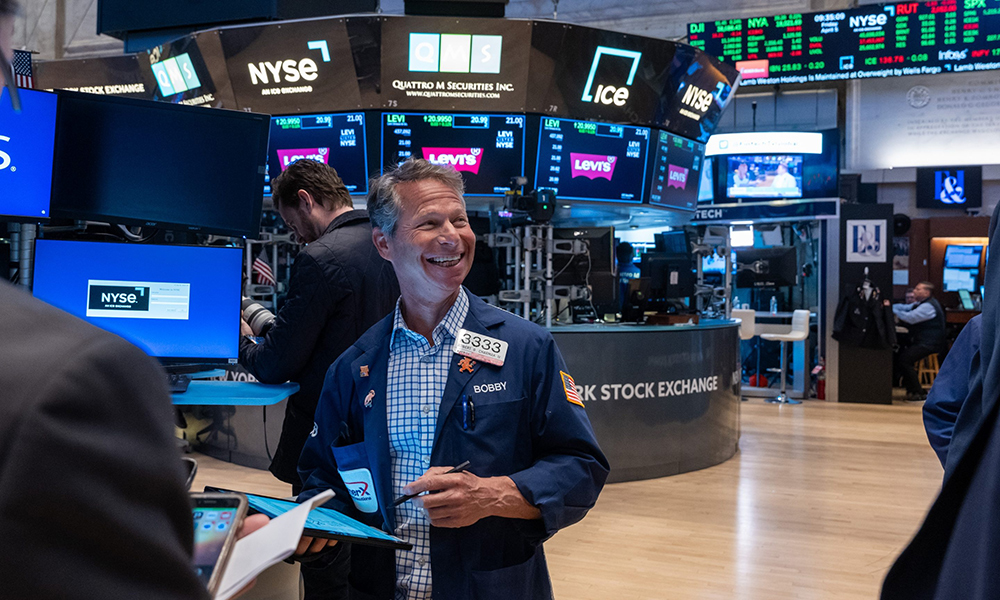
无论是在美国本土还是海外,投资者对人工智能的热情推动科技股今年创下新高。追踪数十个发达和发展中市场大中型科技股的iShares MSCI AC全球信息技术指数(iShares MSCI AC World Information Technology Index)过去12个月飙升逾20%。而在美国国内,备受追捧的追踪美国大盘科技股的景顺QQQ信托系列1交易所交易基金同期上涨了近40%。
这一系列的良好表现是如此引人注目,以至于上周即使是一个小挫折,也引起了华尔街的热议。美国科技股和半导体股分别下跌了1%和2.1%,瑞银全球财富管理公司(UBS Global Wealth Management)美洲区首席投资官索利塔·马切利(Solita Marcelli)提醒投资者,市场修正是正常现象,“人工智能驱动的科技股涨势并非单行道”。
这位资深市场观察人士指出,地缘政治紧张局势升温,以及劳动力市场数据强于预期后美国降息预期的改变,令科技股承压。不过,马切利表示,科技股近期表现不佳并未改变她对人工智能相关股的乐观看法。
她在周一的一份报告中写道:“由于人工智能的基本面强劲,我们预计2024年全球科技公司的盈利将同比增长18%,而且未来12个月的远期市盈率约为27倍,因此我们继续看好全球科技公司,尤其是人工智能价值链上的公司。”
需求和产品增加,而且有证据表明人工智能的应用正在增加
马切利给出了她看好人工智能股票的三大主要原因:“突破性”人工智能产品即将推出;有证据表明人工智能的应用正在增加;需求趋势正在扩大。
自OpenAI于2022年11月向全球发布聊天机器人ChatGPT以来,科技行业一直在竞相发布新人工智能产品。生成式人工智能使文本转视频平台(如OpenAI的Sora)和文本转音乐平台(如Stability AI的Audio 2.0)的兴起成为可能,但人工智能也被用于医疗保健领域,以寻找改变世界并可能带来丰厚利润的新药,它还会带来许多新软件工程应用程序。马切利说,创新的步伐如此之快,她预计“未来数个季度还会造就更多这样的突破性创新”。
新人工智能产品的潜力有助于扩大对该技术的需求。马切利表示,在去年主要由大型科技公司客户引领发展之后,如今“人工智能需求日益普及的迹象更加明显”。她强调,瑞典、新加坡、日本、韩国等主权国家是增量需求的主要来源。
管理着1940亿美元资产的投资管理公司杰尼桑合伙公司(Jennison Associates)的科技股投资组合经理埃里卡·克劳尔也持类似观点。她此前曾向《财富》杂志解释说,世界各国政府基本上都想拥有“自己版本的ChatGPT,利用自己的语言、文献进行训练,从而保留文化细微差别”,这意味着人工智能公司可以利用大量新支出。
埃里卡的观点相当中肯,甲骨文公司(Oracle)董事长兼首席技术官、亿万富翁拉里·埃里森透露,他的公司正与数个国家和主权地区就在云上运行政府应用程序进行谈判,包括人工智能。埃里森在最近的财报电话会议上表示:“几乎每国政府都想拥有自己的主权云。”
至于人工智能应用的证据,瑞银的马切利指出,最近的调查显示,使用人工智能的公司比例不断上升。根据美国人口普查局(U.S. Census Bureau)的《商业趋势与展望调查》(Business Trends and Outlook Survey),虽然截至第一季度,只有5.4%的美国公司在使用人工智能,但这一比例仍远高于2023年第三季度的3.7%。马切利预测,未来6个月,这一比例可能会升至6.6%至12%。
她还指出,科技行业的人工智能采用率要高得多。例如,在人口普查局的信息部门(北美产业分类体系51)中,18%的公司表示它们在第一季度使用人工智能来生产商品或服务。马切利总结道:“我们仍然看好更广泛的人工智能主题。”
最大的威胁:美联储保持鹰派立场
虽然人工智能相关公司仍有一些利好因素,但巨大的威胁即将到来。就在数个月前,投资者还确信美联储将在今年夏天降息。可能出现的借贷成本下降使得股市今年表现优于预期,但近期多份热度高于预期的通胀报告和一些意外强劲劳动力市场数据,让专家们担心美联储近期不会降息。正如Treasury Partners首席投资官理查德·萨普斯登告诉《财富》杂志的那样:“由于失业率低、经济强劲、通胀率高于美联储2%的目标,我们不太可能在7月之前看到任何降息。”
如果情况果真如此,科技股可能会遭遇回调。科技股被视为高风险资产,因此在利率上升时通常会面临压力。萨普斯登警告称,“随着股票估值接近历史高点,推动股价进一步上涨的重担就落在了盈利上”。
他补充说:“鉴于市盈率和债券收益率上升,在财报季提供明确的盈利增长证据之前,我们对股市仍持谨慎态度。”(财富中文网)
译者:中慧言-王芳
无论是在美国本土还是海外,投资者对人工智能的热情推动科技股今年创下新高。追踪数十个发达和发展中市场大中型科技股的iShares MSCI AC全球信息技术指数(iShares MSCI AC World Information Technology Index)过去12个月飙升逾20%。而在美国国内,备受追捧的追踪美国大盘科技股的景顺QQQ信托系列1交易所交易基金同期上涨了近40%。
这一系列的良好表现是如此引人注目,以至于上周即使是一个小挫折,也引起了华尔街的热议。美国科技股和半导体股分别下跌了1%和2.1%,瑞银全球财富管理公司(UBS Global Wealth Management)美洲区首席投资官索利塔·马切利(Solita Marcelli)提醒投资者,市场修正是正常现象,“人工智能驱动的科技股涨势并非单行道”。
这位资深市场观察人士指出,地缘政治紧张局势升温,以及劳动力市场数据强于预期后美国降息预期的改变,令科技股承压。不过,马切利表示,科技股近期表现不佳并未改变她对人工智能相关股的乐观看法。
她在周一的一份报告中写道:“由于人工智能的基本面强劲,我们预计2024年全球科技公司的盈利将同比增长18%,而且未来12个月的远期市盈率约为27倍,因此我们继续看好全球科技公司,尤其是人工智能价值链上的公司。”
需求和产品增加,而且有证据表明人工智能的应用正在增加
马切利给出了她看好人工智能股票的三大主要原因:“突破性”人工智能产品即将推出;有证据表明人工智能的应用正在增加;需求趋势正在扩大。
自OpenAI于2022年11月向全球发布聊天机器人ChatGPT以来,科技行业一直在竞相发布新人工智能产品。生成式人工智能使文本转视频平台(如OpenAI的Sora)和文本转音乐平台(如Stability AI的Audio 2.0)的兴起成为可能,但人工智能也被用于医疗保健领域,以寻找改变世界并可能带来丰厚利润的新药,它还会带来许多新软件工程应用程序。马切利说,创新的步伐如此之快,她预计“未来数个季度还会造就更多这样的突破性创新”。
新人工智能产品的潜力有助于扩大对该技术的需求。马切利表示,在去年主要由大型科技公司客户引领发展之后,如今“人工智能需求日益普及的迹象更加明显”。她强调,瑞典、新加坡、日本、韩国等主权国家是增量需求的主要来源。
管理着1940亿美元资产的投资管理公司杰尼桑合伙公司(Jennison Associates)的科技股投资组合经理埃里卡·克劳尔也持类似观点。她此前曾向《财富》杂志解释说,世界各国政府基本上都想拥有“自己版本的ChatGPT,利用自己的语言、文献进行训练,从而保留文化细微差别”,这意味着人工智能公司可以利用大量新支出。
埃里卡的观点相当中肯,甲骨文公司(Oracle)董事长兼首席技术官、亿万富翁拉里·埃里森透露,他的公司正与数个国家和主权地区就在云上运行政府应用程序进行谈判,包括人工智能。埃里森在最近的财报电话会议上表示:“几乎每国政府都想拥有自己的主权云。”
至于人工智能应用的证据,瑞银的马切利指出,最近的调查显示,使用人工智能的公司比例不断上升。根据美国人口普查局(U.S. Census Bureau)的《商业趋势与展望调查》(Business Trends and Outlook Survey),虽然截至第一季度,只有5.4%的美国公司在使用人工智能,但这一比例仍远高于2023年第三季度的3.7%。马切利预测,未来6个月,这一比例可能会升至6.6%至12%。
她还指出,科技行业的人工智能采用率要高得多。例如,在人口普查局的信息部门(北美产业分类体系51)中,18%的公司表示它们在第一季度使用人工智能来生产商品或服务。马切利总结道:“我们仍然看好更广泛的人工智能主题。”
最大的威胁:美联储保持鹰派立场
虽然人工智能相关公司仍有一些利好因素,但巨大的威胁即将到来。就在数个月前,投资者还确信美联储将在今年夏天降息。可能出现的借贷成本下降使得股市今年表现优于预期,但近期多份热度高于预期的通胀报告和一些意外强劲劳动力市场数据,让专家们担心美联储近期不会降息。正如Treasury Partners首席投资官理查德·萨普斯登告诉《财富》杂志的那样:“由于失业率低、经济强劲、通胀率高于美联储2%的目标,我们不太可能在7月之前看到任何降息。”
如果情况果真如此,科技股可能会遭遇回调。科技股被视为高风险资产,因此在利率上升时通常会面临压力。萨普斯登警告称,“随着股票估值接近历史高点,推动股价进一步上涨的重担就落在了盈利上”。
他补充说:“鉴于市盈率和债券收益率上升,在财报季提供明确的盈利增长证据之前,我们对股市仍持谨慎态度。”(财富中文网)
译者:中慧言-王芳
Investors’ AI enthusiasm has helped lift technology stocks to new heights this year, both in the U.S. and abroad. The iShares MSCI AC World Information Technology Index, which tracks large- and midcap tech stocks in dozens of developed and developing markets, has surged more than 20% over the past 12 months. And domestically, the vaunted Invesco QQQ Trust Series 1 ETF, which tracks large-cap U.S. tech stocks, is up nearly 40% over the same period.
The run of good form has been so dramatic that even a minor speed bump last week has Wall Street talking. A mere 1% decline in U.S. tech stocks and a 2.1% decline in semiconductor shares led Solita Marcelli, chief investment officer Americas at UBS Global Wealth Management, to remind investors that corrections are natural—“the AI-driven tech rally is not a one-way street.”
The veteran market watcher noted that rising geopolitical tensions and changing forecasts for U.S. interest rate cuts after stronger than expected labor-market data were weighing on tech shares. Still, Marcelli said tech’s very recent underperformance hasn’t changed her positive view of AI-related stocks.
“With robust AI fundamentals, our expectations of 18% year-over-year earnings growth for global tech in 2024, and a reasonable 12-month forward price-to-earnings ratio of around 27x, we stay positive on global tech and companies in the AI value chain in particular,” she wrote in a Monday note.
More demand, more products, and evidence of increasing adoption
Marcelli gave three key reasons for her optimism on AI stocks: the imminent launch of “revolutionary” AI products; evidence of increasing AI adoption; and broadening demand trends.
Ever since OpenAI released its chatbot ChatGPT to the world in November 2022, there’s been a race to release new AI products in the tech sector. Generative AI has enabled the rise of text-to-video platforms like OpenAI’s Sora and text-to-music platforms like Stability AI’s Audio 2.0, but AI is also being used in health care to look for world-changing and potentially lucrative new drugs, and it has numerous new software engineering applications. Marcelli said that the pace of innovation is so strong that she expects “more such breakthrough innovations in the next few quarters” as well.
The potential for new AI products is likely to help broaden demand for the technology. After mostly being led by Big Tech customers last year, Marcelli said there are now “clearer signs of AI demand becoming more ubiquitous.” She highlighted sovereign entities including Sweden, Singapore, Japan, Korea, and more as key sources of incremental demand.
Erika Klauer, a technology equity portfolio manager at Jennison Associates, an investment management firm with $194 billion in assets under management, shared a similar view. She previously explained to Fortune that governments around the world essentially want “their own version of ChatGPT, with training on their own languages … their own archives, their own cultural nuances,” and that means a lot of new spending for AI companies to take advantage of.
To her point, the billionaire chairman and chief technology officer of Oracle, Larry Ellison, revealed that his company is negotiating with several countries and sovereign regions to run government applications on the cloud, including AI. “Pretty much every government is going to want a sovereign cloud,” Ellison said on a recent earnings call.
As far as evidence of AI adoption, UBS’s Marcelli pointed to recent surveys that show a rising percentage of companies using AI. While only 5.4% of U.S. companies were using AI as of the first quarter, according to the U.S. Census Bureau’s Business Trends and Outlook Survey, that’s still well above the 3.7% figure from the third quarter of 2023. And Marcelli predicted that this share could rise to between 6.6% and 12% over the next six months.
She also noted that AI adoption rates are much higher in the tech sector. In the Census Bureau’s information sector (NAICS 51), for example, 18% of companies said they used AI to produce goods or services in the first quarter. “We remain positive on the broader AI theme,” Marcelli concluded.
The big threat: A hawkish Fed
While AI-related companies still have some tailwinds, there is a big threat on the horizon. Just months ago, investors were certain that the Federal Reserve would be cutting interest rates this summer. The potential for lower borrowing costs helped the stock market outperform this year, but multiple hotter-than-expected inflation reports and some surprisingly strong labor market data recently have led experts to fear that the Fed won’t be cutting rates anytime soon. As Richard Saperstein, chief investment officer at Treasury Partners, told Fortune: “With low unemployment, economic strength, and inflation above the Fed’s 2% target, it’s unlikely we’ll see any rate cuts before July.”
If that turns out to be the case, tech stocks, which are seen as higher-risk assets and thus typically face pressure when rates rise, could suffer a pullback. And Saperstein warned that “with stock valuations near record highs, the burden is on earnings to drive further rises in stock prices.”
“Given the elevated market multiples and rising bond yields, we remain cautious on stocks until earnings season delivers clear evidence of earnings growth,” he added.






